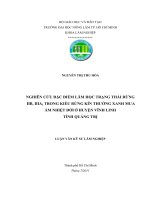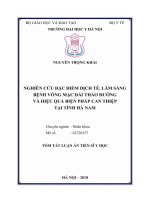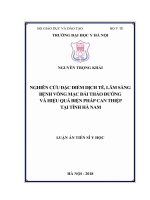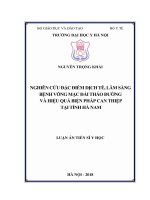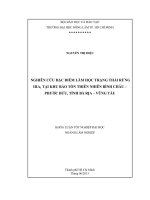Nghiên cứu đặc điểm sinh học, sinh thái của ong anisopteromalus calandrae (howard) ký sinh mọt cánh cứng hại trong kho tại tỉnh đồng tháp tt tiếng anh
Bạn đang xem bản rút gọn của tài liệu. Xem và tải ngay bản đầy đủ của tài liệu tại đây (493.22 KB, 28 trang )
MINISTRY OF EDUCATION
AND TRAINING
VIETNAM ACADEMY
OF SCIENCE AND TECHNOLOGY
GRADUATE UNIVERSITY OF SCIENCE AND TECHNOLOGY
-----------------------------
NGUYEN THI OANH
INVESTIGATION OF BIOLOGICAL, ECOLOGICAL
CHARACTERISTICS OF Anisopteromalus calandrae (Howard)
PARASITIZING STORED PRODUCT BEETLE PESTS
IN DONG THAP PROVINCE
Major: Entomology
Code: 9 42 01 06
SUMMARY OF THE DOCTORAL THESIS
IN BIOLOGY
HA NOI – 2019
This work was completed at: Graduate University of Science and
Technology - Vietnam Academy of Science and Technology
Academic Title, Name of Supervisors:
1. Assoc. Prof. Dr. Tran Ngoc Lan
2. Assoc. Prof. Dr. Truong Xuan Lam
Referee 1:………………………………………….
………………………………………..
Referee 2: …………………………………………
..………………………………………
Referee 3: …………………………………………
………………………………………..
The Dissertation will be defended before the Doctoral Examination
Board of Graduate University of Science and Technology - Vietnam
Academy of Science and Technology at.……Date ..….. /........ / 2019.
The Dissertation can be accessed from:
- The library of Graduate University of Science and Technology
- The National Library of Viet Nam
1
GENERAL INFORMATION
1. The importance for doing the thesis
Post - harvest losses of agricultural products are always a
concern in agricultural countries, especially in tropical areas. The main
reason causing the demage is due to insect pests. Every year, the global
crop loss is about 5 - 10% (Hodges et al., 2014). Viet Nam is one of the
countries which has the highest loss of agricultural post - harvest
products in Asia with from 11 to 13% rice, and from 13 to 15% maize
lost (Ministry of Agriculture and Rural Development, 2009). According
to the Organization of the Component of Post - harvest Processing, the
loss of post - harvest rice is 11.6%, and maize is approximately 18 19% in the Red River Delta region and other regions. In the Mekong
Delta, the loss of post - harvest rice is about 13.7%.
The main way currently applied to control stored agricultural
products is the chemical method by which phosphine was used.
However, this method cannot completely control insect pests, but it
kills useful insects and other animals. The method also causes
chemical resistance in harmful insect pests of stored agricultural
products. Moreover, phosphine is toxic to human and causes
contaminated environment. Fortunately, a number of research on
using useful parasitic species such as Hymenoptera to control the
harmful pests damaging stored agricultural products have been
conducted. Among the parasitoids, Anisopteromalus can hinder some
Coleoptera species, but no study in this subject has been carried out
in Viet Nam.
2
Given the above practical and scientific requirements, this
study investigates the biological, ecological characterizations of
Anisopteromalus calandrae.
2. Objectives of study
- To identify natural enemies for stored - product pests in
Dong Thap province.
- To study biological and ecological characteristics of A.
calandrae.
- To evaluate the ability to control S. zeamais and
L. serricorne by A. calandrae in laboratory conditions.
3. Scientific and practical significance of the thesis
Scientific significance: this thesis provides a list of natural
enemy species for agricultural insect pests in Dong Thap Province.
Data about morphological, biological, behavioral and ecological
characteristics of A. calandrae parazitizing L. serricorne is also
obtained. Besides, the ability to control S. zeamais and L. serricorne
was shown in this study.
Practical significance: The obtained data are scientific
background for proposing a method to use A. calandrae to control
agricultural insect pests in warehouses in Dong Thap Province as
well as in the Mekong Delta.
CHAPTER I.
SCIENTIFIC BASIS AND DOCUMENT OVERVIEW
1.1 Scientific basic of thesis
Harmful insect pests usually appear in stored agricultural
products. Sometimes only several weeks of storage, pests develop to
high density devasting a part or most agricultural products (Bui Cong
3
Hien, 1995). Pests cause to reduce quantity and quality of agricultural
products, or even totally destroy them (Bui Cong Hien and Tran Huy
Tho, 2003).
Dong Thap Province located in the Mekong Delta, where a
number of storehouses used for preserving agricultural products such
as rice, maize, beans, etc. The diversity of storehouses and stored
products is a favorable condition for the spread and development of
harmful insects. However, the use of phosphine is the main method
to control insect pests in Viet Nam as well as in Dong Thap, while
the Intergrated Pest Management (IPM) has not been properly
applied. Thereby, determination of biological characterizations of A.
calandrae is necessary to control stored insect pests. This study
provides a biological and safe method instead of using insecticides to
control these pests.
1.2. Reports in the world relating to this study
1.2.1. Studies of natural enemy species for stored insect pests
A number of reports on natural enemy species for harmful
insects have been published. For examples, Lebeck (1991) described
22 species of natural enemies for these pests. Sedlacek et al. (1998)
recorded 7 parasitoid species parasitizing insects damaging stored
argiultural products. A. calandrae is one of 9 parasitic species in 4
families (Encyrtidae, Eulophidae, Bethylidae and Pteromalidae)
recorded in Southern Africa (Helbig, 1998). In Thailand, Hayashi et
al. (2004) listed 29 prey species and 19 parasitoid species for stored
insect pests.
4
1.2.2. Studies of Anisopteromalus calandrae
1.2.2.1. Morphological and biological characteristics of L.
serricorne (a host of A. calandrae)
Morphological and biological characteristics of L. serricorne have
been determined by Visarathanonth (1985), Ryan (1999) and Mahroof
and Phillips (2008). The authors also reported that the life cycle, logevity
and egg laying of L. serricorne depended on its food types.
1.2.2.2. Morphological characteristics of A. calandrae
Morphological characteristics of A. calandrae have been
described by some authors (Hayashi et al. 2004; Baur et al. 2014).
Some details of Anisopteromalus were described with pictures and
keys to its species.
1.2.2.3. Behaviors of A. calandrae
Biological Studies of behaviors of A. calandrae such as egg
laying on large - sized hosts (usually 4th larvae instar). The behaviors
including host searching, host stinging have been described.
Moreover, the host searching at different depths (such as 14.5 cm) of
the grain mass has been studied.
1.2.2.4. Biological characteristics of A. calandrae
Studies of the life cycle and reproduction of A. calandrae show
that the egg stage lasts 1 - 1.5 days on average. The life cycle of the
parasitoid is from 11.4 days to 26.6 days depending on temperature,
host larvae and complementary food, while adult longevity was in a
range of 9.6 - 26.6 days. The progeny numbers produced by a female
were 80.9 - 240.0. However, sometimes male longevity was only 5.4
- 6.0 days depending on its hosts. The lower developmental threshold
5
and the thermal constant of A. calandrae were determined as 11.5oC
and 263.2 degree - days, respectively.
1.2.2.5. Ecological characteristics of A. calandrae
Studies of ecology of A. calandrae including the competition
with other parasitoid species have been published. Effects of food or
food supplement and host density on the development A. calandrae
have also been determined. The investigation of temperature
influence on its development shows that the life cycles are various at
20, 25, 30°C, but no statistical difference on these at the temperature
of 30°C and 35°C has been found.
1.2.2.6. Ability to control stored insect pests of A. calandrae
Previous studies showed that A. calandrae effectively
controlled some species for stored insect pests. The performance of
controlling these species ranged from 32.24% to 85.0% depending on
agricultural seeds and preservation methods.
1.3. Research in Vietnam
1.3.1. Research on natural enemies for stored insect pests
There are only some studies of natural enemy species for
stored insect pests in Viet Nam. Some authors reported these subjects
such as Duong Minh Tu (2005) and Tran Van Hai (2008), Nguyen
Quy Duong (2010), Nguyen Van Duong and Khuat Dang Long
(2017). Most studies reported species compositions in specific places,
but no publication showed the presence of A. calandrae.
1.3.2. Studies of morphological and biological characteristics of L.
serricorne
The investigation of L. Serricorne on tobacco, hot peppers, rice
and stored peanuts was carried out by Bui Cong Hien (1995).
6
However, the Studies of morphological and biological characteristics
of L. serricorne damaging produced fish food have not been
documented yet.
1.3.3. Studies of biological characteristics, behaviors, ecology and
the ability to control stored insect pests of A. calandrae
No research on biological characteristics, behaviors, ecology
and the ability to control stored insect pests of A. calandrae has been
carried out in Viet Nam so far.
General comments of related studies in Vietnam
Overall, natural species of agricultural insect pests in
storehouses in Vietnam have been investigated by some authors. For
examples, Duong Minh Tu (2005) recorded 2 natural species in
Northern Vietnam. 2 species were recorded by Tran Van Hai et al.,
(2008) in Can Tho and An Giang Province. In 2010, Nguyen Quy
Duong described 7 species of natural enemies for stored pests on
beans in Vietnam, including 3 parasitic species. Nguyen Van Duong
and Khuat Dang Long (2017) recorded 6 species of parasitoids on
maize in Son La. These results showed that only some the research
on natural enemies of stored - grain pests in the storehouses have
been conducted. Most publications have focused on recording the
presence and general description of natural enemies species, but have
not studied in details. Studies of biology, behaviors and ecology as
well as control ability of A. calandrae for stored - grain pests in
Vietnam have not been conducted yet.
7
CHAPTER II. STUDYING SITES AND TIME AND METHODS
2.1. Time and sites for studying
2.1.1. Time for studying
The research was conducted from November 2015 to
December 2018.
The sampling and field survey were carried out one time per
month, 5 - 7 days per time, from November 2015 to December 2016.
Further experiments were conducted in laboratory from 2016 to 2018.
2.1.2. Sites for researching
The investigation of natural enemy species for controlling
stored
agricultural
products
was
conducted
in
agricultural
storehouses in countryside and town sites in Dong Thap Province,
including Cao Lanh district, Thanh Binh district, Lap Vo district,
Chau Thanh district, Cao Lanh city and Sadec city. A number of
agricultural products and aquafeed types were collected from
processing companies, mainly from Sadec city.
2.2. Preparation of insects and scale of the study
Preparation of insects
- Natural enemy species for stored insect pests.
-
Anisopteromalus
calandrae
(Howard) (Hymenoptera:
Pteromalidae).
Scale of the study
The investigation of natural enemy species for agricultural
insect pests in storehouses was conducted in Dong Thap Province.
The biological and ecological characteristics of A. calandrae
parasitized and grew on larvae of L. serricorne. The ability to control
8
L. serricorne and S. zeamais by A. calandrae was evaluated in
laboratories in Dong Thap University.
2.3. Proposal outline
- Investigation of natural enemy species stored - product pests
in Dong Thap Province.
- Study of characteristics of morphology, biology, behaviors
and ecology for parasitoid A. calandrae in the laboratory conditions,
and some these characteristics of S. zeamais.
- Study of the ability to control S. zeamais and L. serricorne
by A. calandrae in laboratory conditions.
2.4. Materials
2.4.1. Materials
- Catfish feed pellets (8 mm in diameter) were processed from
raw materials including rice bran, broken rice, maize, soy, wheat
grain and some other essential substances.
- Bean seeds (Vigna unguiculata), corn seeds (Zea mays).
- Some Coleoptera species are hosts of A. calandrae such as L.
serricorne (Anobiidae), S. zeamais (Curculionidae) and C. maculatus
(Bruchidae).
2.4.2. Chemicals and laboratory devices
- Stainless steel samplers, sieves, insect sweep net samplers,
flashlights.
- Plastic containers, plastic rectangle boxes (length × width ×
height of 17 cm × 13 cm × 7 cm), plastic cylinder containers (20 cm
in height, 14 cm in diameter of mouth and bottom), and plastic
cylinder containers (7 cm in height, 12 cm in diameter of mouth and
9 cm in diameter of bottom);
9
- Petri dishes with 8 cm in diameter;
- Carton boxes (length × width × height of 45 cm × 28 cm × 22 cm);
- Soft polyethylene bags (55 cm in length, 36 cm in width);
- Cover nets with mesh size < 0.01 mm and from 0.40 to 1.20 mm;
- A magnifier with 70 times of magnification;
- Microscope (Meiji Techno DK3000, Japan) with 1000 times
magnification connecting to a computer with capture software of
Lumenera INFINITY1 - 3C (Canada);
- Camera Sony DSC W - 800 20.1 Mega;
- Drying oven Memmert UN55 (Germany);
- Sanyo refrigerated incubator, type MIR - 153 (Japan);
- Extech temperature meter (Taiwan) and thermometer;
- Digital Grain Moisture Meter Tester MD - 7822;
- Digital Thermometer and Hygrometer HTC - 2;
- And other devices.
2.5. Methods
2.5.1. Investigation of natural enemy species for stored agricultural
products.
There are two methods used in this experiment.
- Investigation of the natural enemy species for stored
agricultural products was carried out according to the plant
quarantine method (based on Vietnamese standard: TCVN 4731 89). The natural enemy species were collected manually and using
sampling collector nets. Collected insects were stored in carton
boxes, soft polyethylene bags and glass tubes.
- Samples with stored - grain possibly infested with pests were
taken to the laboratory, stored in plastic containers covered with
10
ventilable textile fabric. The containers were monitored to the
appearance of natural enemy species for stored insect pests. These
species were collected and then stored in 70% alcohol solution for
analysis.
- Natural enemies species ware classified according to the
documents of Graham (1969), Yoshimoto (1984), Janzon (1986),
Boucek and Rasplus (1991), Noyes (2003), Hayashi et al. (2004),
Lim et al. (2007), Baur et al. (2014) and Fayaz et al. (2016).
Meanwhile, L. serricorne, S. zeamais and C. maculatus were
classified based on the description of Haines (1991), Bui Cong Hien
(1995) and Chaisaeng (2007).
The abundance of a natural enemy species was determined as
following equation:
Abundance(%)
a 100
b
where a is numbers of sites with the appearance of a species, and b is
the total numbers of sites.
The appearance ratio of a species was determined as following
equation:
A 100
B
where A is the appearance times of a species, and B is total
investigation times.
Appearance ratio (%)
11
2.5.2. Morphological, biological and ecological characteristics of A.
calandrae
The morphological characteristics of A. calandrae were
measured and recorded to compare with the description of
Pteromalidae family by Graham (1969), Yoshimoto (1984), Hayashi
et al. (2004), Sureshan (2007), Janzon (1986), Baur et al. (2014).
Moreover, the biological, behavioral and ecological characteristics of
A. calandrae were also studied.
2.5.3. Determination of the ability to control stored - product pests
by A. calandrae
This experiment was conducted according to Chaisaeng (2007)
and Visarathanonth et al. (2010).
2.5.4. Photographing and data analysis
Photographing:
A.
calandrae
was
observed
using
stereomicroscope Meiji Techno DK3000 (Japan) with 70 times
magnification. The measurement of specimens and picture processing
were conducted using scale ruler Lumenera INFINITY1 - 3C
software (Canada).
Data analysis: Obtained data are shown as the mean ± one
standard deviation. Microsoft Excel 2010 was used to set up grapths,
while the SPSS software program version 22.0 was used to analyze
variance, and significant differences (p < 0.05) were calculated using
Duncan’s test.
12
CHAPTER 3. RESULTS AND DISCUSSION
3.1. Species composition of natural enemies for stored - product
insect pests in Dong Thap Province
3.1.1. Species composition of natural enemies for stored - product
insect pests
13 natural enemies for stored - product insect pests were
recorded during the survey for 12 months. These species were in 10
families and 5 orders. 5 of them were carnivorous species, including
Tyrophagus
(Dermaptera),
putrescentiae
Xylocoris
(Acarina),
flavipes
and
Forficula
auricularia
Amphibolus
venator
(Heteroptera), and Chelifer cancroides (Pseudoscorpionida). 9
species are parasitoids of Hymenoptera.
3.1.2. Appearance ratio of natural enemies depending on types of
agricultural products in storehouse
The survey results showed that there were 11 species of natural
enemies appearing in all samples of rice and wheat grains. 10, 9, 8
and 6 these species were found in aquafeed, maize grains, beans and
rice bran, respectively, while only 2 species appeared in cassava
samples. A. calandrae was found in 5 types of 7 stored agricultural
products with the appearance ratios greater than 80%.
3.2. Morphological, biological and ecological characteristics of A.
calandrae
3.2.1.
Some
morphological
and
biological
characteristics
L. serricorne - host of A. calandrae
All stages the L. serricorne growing on aquafeed at 30 ±
o
1.07 C, humidity of 74.64 ± 3.17% were recorded. The results
showed that the life cycle of L. serricorne is 41.53 ± 6.21 days on
13
average. The egg stage of the beetle was 7.10 ± 0.76 days, the 5th
larvae stage was 26.4 days, pupa stage was 4.23 ± 0.82 days, while
adult stage ranged from 33 to 53 days (temperature 30 ± 1.07oC,
humidity 74, 64 ± 3.17%).
3.2.2. Morphologcal characteristics of A. calandrae
Whole body of A. calandrae is dark - green color (Figure 3.8).
Only males have gaster with milky white or opaque yellow colors on
the 2nd, 3rd and 4th tergites. When parasitizing L. serricorne, females
and males have a body length of 3.5 ± 0.3 mm and 2.4 ± 0.5 mm on
average, respectively. The compound and ocellus eyes are reddish
brown. An antenna has 13 segments (including scale). Legs with
black coxae, black or brown, and yellow tibiae were identified. Each
tarsus has 5 segments. Forewings have hard hairs, speculum bare and
setea on wing disc dark. A space under forewings mergin has not any
hair (Figure 3.8).
Figure. 3.8. Adults of A. calandrae
14
3.2.3. Biological characteristics of A. calandrae
3.2.3.1. Activity behaviors of parasitoid adult
The number of eggs in L. serricorne and a host insect
On larvae of L. serricorne, A. calandrae females usually laid
an egg on a host with 82.47%. Some females laid 2, 3, 4 and 5 eggs
on a host with 10.31%, 5.62%, 1.12% and 0.47%, respectively. The
ratios of A. calandrae emerged from a pupa with 1, 2, 3, 4 and 5 eggs
were 85.45%, 47.27%, 28.33%, 25.0% and 20.0%, respectively.
Behaviors of courtship and ovipositor
- The courtship behavior of parasitoid males and the reaction
of females
When a male of the parasitoid encountered a female, he often
run around and flirted with the female. The total time that the male
run, flapped their wings and moved around the female was
approximately 44.80 ± 10.40 seconds. Thereafter, the time that male
jumped on the female’s abdomen and stroked the female’s antennae
lasted 16.45 ± 2.21 seconds.
- Ovipositor
An A. calandrae male jumped on the back of the female, then
moved to her abdomen to perform mating if the female agreed. The
sex making lasted 22 ± 2.70 seconds.
15
-
Successful ovipositor process and ovipositor time of A.
calandrae
Table 3.6. Successful ovipositor process and ovipositor time of A.
calandrae
Numbers of
mating
couples
16
Mating after flirting (%)
Lần 1
Lần 2
Lần 3
53.33
8
Mating time
(seconds)
87.50 ± 3.10
26.67
6
68.25 ± 5.31
20.00
56.67 ± 3.98
Host finding behavior of A. calandrae
After ovipositor for about 1 day, females began to probe
signals for finding their hosts by moving slowly on the grain mass
surface. A female often identified a suitable host by using their
mouths and antennae for laying her eggs.
Host selection to lay eggs of a A. calandrae female
When exposed to hosts at different age stages (stages of 1 - 5),
prepupae and pupae of L. serricorne, a A. calandrae female tended to
choose larvae stages of the 2nd, 3rd and 4th or prepupae and pupae.
However, females do not lay eggs on the 1st and 5th larvae.
3.2.3.2. Behaviors of larvae
A. calandrae laid its eggs on any position on the host body.
After hatching, larvae of the 1st stage moved to an appropriate host
and clung on the host. They sucked up the nutrient fluid from the host
until reaching the 4th stage and becoming pupae. Larvae grew quickly
from the first to the 4th stage.
16
3.2.3.3. Life cycle of A. calandrae parasitizing L. serricorne
The development of A. calandrae in laboratory conditions (30
o
± 1.0 C, 75 ± 3.1% RH) is shown in Table 3.7.
Table 3.7. The development of A. calandrae parasitizing L.
serricorne
Stage
N0
Time (days)
samples
Range
Mean
Egg
45
1.00 - 2.00
1.22 ± 0.42
st
115
1.00 - 1.40
1.08 ± 0.12
nd
102
1.00 - 1.50
1.21 ± 0.17
rd
104
1.00 - 1.70
1.30 ± 0.16
th
4 larvae instar
106
1.20 - 2.20
1.80 ± 0.24
Larvae instar stage
427
4.20 - 6.80
5.39 ± 0.69
Prepupae
48
0.30 - 0.70
0.49 ± 0.09
Pupae
45
7.00 - 10.00
8.58 ± 0.75
Prenatal stage
45
1.00 - 4.00
1.64 ± 0.77
13.50 - 23.60
17.32 ± 2.72
1 larvae instar
2 larvae instar
3 larvae instar
Total time of female life
The life cycle of A. calandrae is short and shown in Figure
3.31 with 17.3 ± 2.7 days on average. The time for egg development
is 1.2 ± 0.4 days, larval phase was 5.4 ± 0.3 days, prepupa phase is
0.5 ± 0.1 days, pupa phase is 8.6 ± 0.7 days. The time to lay eggs is
1.6 ± 0.8 days.
17
Figure 3.31. Life cycle of A. calandrae
3.2.3.4. Longevity, parasitic ability and egg laying of A. calandrae
parasitizing L. serricorne
When feeding with honey solution (30%), females and males
of A. calandrae could live 27.07 ± 2.89 and 24.33 ± 2.64 days,
respectively. A female laid 71.13 ± 4.24 eggs in its life with 2.65 ±
0.28 eggs/day. The number of emerged adults was 55.00 ± 4.94 from
a female of which 37.00 ± 4.12 females in its progeny.
Egg laying rhythm of A. calandrae the larvae of L. serricorne
During the life time, the average number of a female laid from
0.07 eggs/day on the first day to 7.4 eggs/day on the 9th day and then
gradually decreased until the female died (Figure 3.33).
18
Eggs/day/female
8
6
4
2
0
1
3
5
7
9 11 13 15 17 19 21 23 25 27 29 31
Age of female (days)
Figure 3.33. Egg laying rhythm of A. calandrae
3.2.3.5. Temperature threshold for development
In all development phases of A. calandrae, the highest
temperature threshold was at 12.96°C, followed by larvae stage (at
12.54°C), egg stage (at 8.77oC), prepupa (at 6.85oC), and emerged
from pupae (5.78oC). The threshold for the whole life cycle is at
12.09oC.
3.2.4. Ecological characteristics of A. calandrae
3.2.4.1. Effects of temperature on the development of A. calandrae
Life cycle time of A. calandrae developed at 20oC and
75% RH.
When A. calandrae grew at 20oC and 75% RH, its life cycle
was 45.38 ± 3.45 days, which was significantly longer than that at
room temperature with 17.32 ± 2.72 days.
19
Table 3.10. Development of A. calandrae on larvae of L. serricorne
(at 20oC, 75% RH)
Stage development
N0
Development time (days)
samples
Range
Means
Egg stage
45
2.00 - 3.00
2.63 ± 0.34
1st larvae instar
112
1.80 - 2.90
2.32 ± 0.30
nd
106
1.90 - 3.50
2.58 ± 0.41
rd
108
2.40 - 3.50
2.95 ± 0.33
th
4 larvae instar
109
2.60 - 4.00
3.20 ± 0.31
Larvae instar stage
435
8.70 - 13.90
11.05 ± 0.35
Pupa
55
0.50 - 1.60
0.98 ± 0.23
Prepupa
45
25.00 - 32.00
27.76 ± 1.19
Prenatal stage
45
2.30 - 4.00
2.96 ± 0.34
38.50 - 54.50
45.38 ± 3.45
2 larvae instar
3 larvae instar
Total time of female life
o
Life cycle time of A. calandrae at 25 C and 75% RH
When A. calandrae grew at 25oC and 75% RH, its life cycle
was shorter compared to at 20oC and 75% RH. The results are
presented in Table 3.11.
Table 3.11. Development of A. calandrae on larvae of L. serricorne
(at 20oC, 75% RH)
Stage development
Egg stage
N0
Development time (days)
samples
Range
Means
45
1.00 - 2.50
1.82 ± 0.48
st
105
1.00 - 1.60
1.32 ± 0.16
nd
106
1.00 - 2.00
1.37 ± 0.23
rd
108
1.30 - 2.40
1.69 ± 0.22
th
109
1.50 - 2.50
2.09 ± 0.21
1 larvae instar
2 larvae instar
3 larvae instar
4 larvae instar
20
Larvae instar stage
428
4.80 - 8.50
6.47 ± 0.82
Pupa
51
0.50 - 1.00
0.71± 0.16
Prepupa
45
14.00 - 20.00
16.62 ± 1.50
Prenatal stage
45
1.00 - 4.00
2.19 ± 0.55
17.50 - 34.50
17.50 - 34.50
Total time of female life
The development of A. calandrae was apparently affected by
temperature when it parasitized L. serricorne. When it grew at 75%
RH and at 20oC, 25oC and 30oC, the life cycles were longer at lower
temperatures. The life cycles lasted 45.38 ± 3.45, 27.80 ± 3.51 and
17.32 ± 2.72 days at these temperatures, respectively.
3.2.4.2. Effects of hosts and food supplement on the longevity, and
egg laying of A. calandrae
Mature females and males could live for 10.73 ± 1.72 and
10.52 ± 1.98 days, respectively, when they were fed on only distilled
water. Meanwhile, their logevities were longer when they were fed
on honey bee solutions from 10% to 50%. The highest longevity of
females and males were recorded when A. calandrae was fed on
honey solution at 30%.
3.2.4.3. Effects of host density on egg production of female A.
calandrae
The experiment showed that the number of L. serricorne larvae
suitable for 1 pair of A. calandrae was about 25 - 30 host larvae
(Table 3.16).
21
Table 3.16. Correlation between the density of L. serricorne larvae
and the number of parasitic hosts, the number of parasitic eggs/hosts
Density of larvae
Parasitized larvae
Eggs/host/day
(individuals)/box
(individuals)/day
20
3.87
2.67
25
2.64
1.53
30
2.51
1.08
3.2.4.4. Effects of A. calandrae density on the sex ratio of their
offspring parasitizing S. zeamais and L. serricorne
A. calandrae was released at different densities to control S.
zeamais and L. serricorne. The results showed that the increase of
released A. calandrae reduced the ratio of male to female in their
descendants in general.
3.3. Ability to control insect pests by A. calandrae in the
laboratory condition
3.3.1. Ability of A. calandrae to control S. zeamais fed on Vigna
unguiculata
After releasing 6, 8 and 10 couples of A. calandrae, the
appearance of S. zeamais fed on V. unguiculata reduced by 30.0 ±
2.1%, 28.7 ± 1.7% and 23.1 ± 2.0%, respectively.
3.3.2. Ability to control L. serricorne fed on aquafeed by A.
calandrae
After releasing 10 couples of A. calandrae to control S.
zeamais fed on aquafeed for 3 months, the L. serricorne was reduced
by nearly 85%.
22
3.3.3. The ability of A. calandrae to control L. serricorne fed on
aquafeed
The experiment was carried our using 100 g tablets of
aquafeed placed in a carton box. After 3 months, the number of
L. serricorne was reduced by 72.2 - 80.9%. In another experiment
carried out in a carton box containing 5 kg the aquafeed, the number
of L. serricorne was reduced by 74.8 - 82.3%.
CONCLUSION AND RECOMMENDATION
Conclusion
1. 13 species natural enemies of stored - product insect pests in
Dong Thap Province were identified. These species were 5 carnivorous
species and 8 parasitoid species, and belong to 10 families, 5 orders. 11
species were first recorded in agricultural stored - product in Dong
Thap, and 8 species were considered as natural enemy species in stored
- product in Viet Nam. Among these species, A. calandrae was found
at over 80% in 5/7 types of stored - product.
2. The life cycle of A. calandrae grew on L. serricorne is 17.3
days (at 30°C, 75% RH). An individual of A. calandrae laid 71.1
eggs and parasitized 63.2 young larvae on average. 55 individuals
(37.0 females) were produced from a female. A femele laid from 1.0
to 12.0 eggs/day, and from 1.0 to 5.0 eggs/host larva. 82.5% females
laid 1 egg on a host.
23
3. A. calandrae has a behavior to lay eggs on hosts who hide in
agricultural seeds. There is no egg laid on freely moving larvae
outside the seeds. Females prefer to lay eggs on 3rd larvae instar and
4th larvae instar, while no egg was laid on 1st larvae instar and 5th
larvae instar.
4. The developmental threshold and thermal constant of A.
calandrae were determined as 12.09oC and 358.9 degree - days. The
life cycles were 17.3, 27.8 and 45.4 days at 20oC, 25oC and 30oC.
The honey solution (30% honey) was a suitable nutrient supplement
for A. calandrae. Temperature and humidity conditions also affected
the development of A. calandrae. Its longevity was 39.1, 30.9 and
27.1 days at 20oC, 25oC and 30oC, respectively.
5. In laboratory conditions, A. calandrae could reduce the S.
zeamais fed on while pea by 77% after 6 months, and L. serricorne
fed on aquafeed by 85% after 3 months.
Suggestion
1. The application of A. calandrae should be further studied.
The experiments about mass rearing and release of the parasitoid into
small agricultural stores should be carried out.
2. The morphological, biological and ecological characteristics
of A. calandrae can be used as training materials for responsible
people working in agricultural companies, household businesses, and
agricultural product preservation system and pest investigation.
3. Obtained data in this Study of the ability to control the
insect pests by A. calandrae can be used to reduce the damage of
agricultural products during storage.


